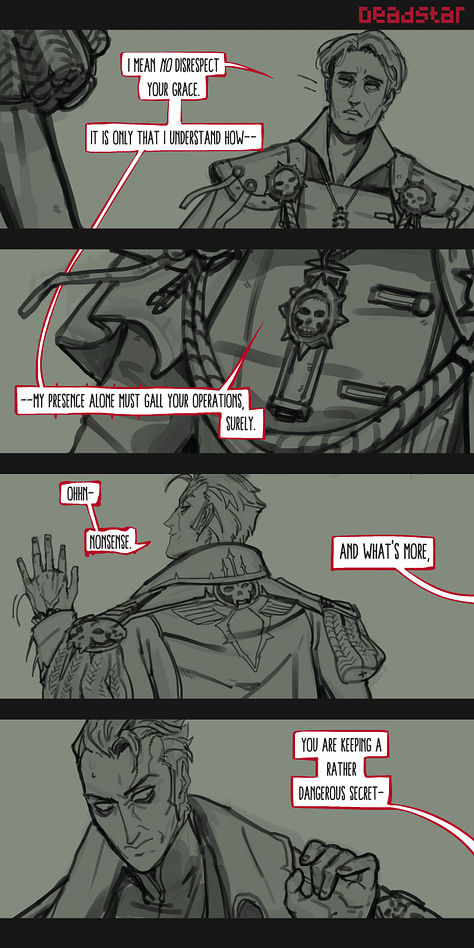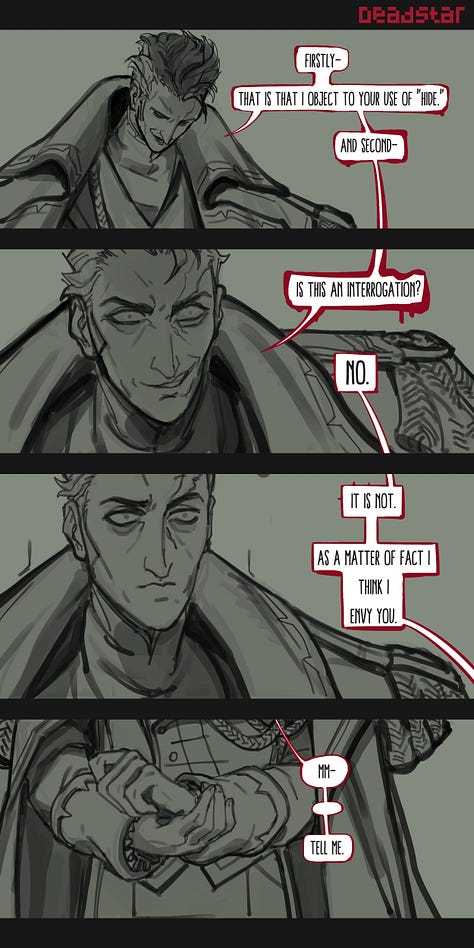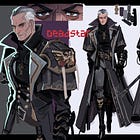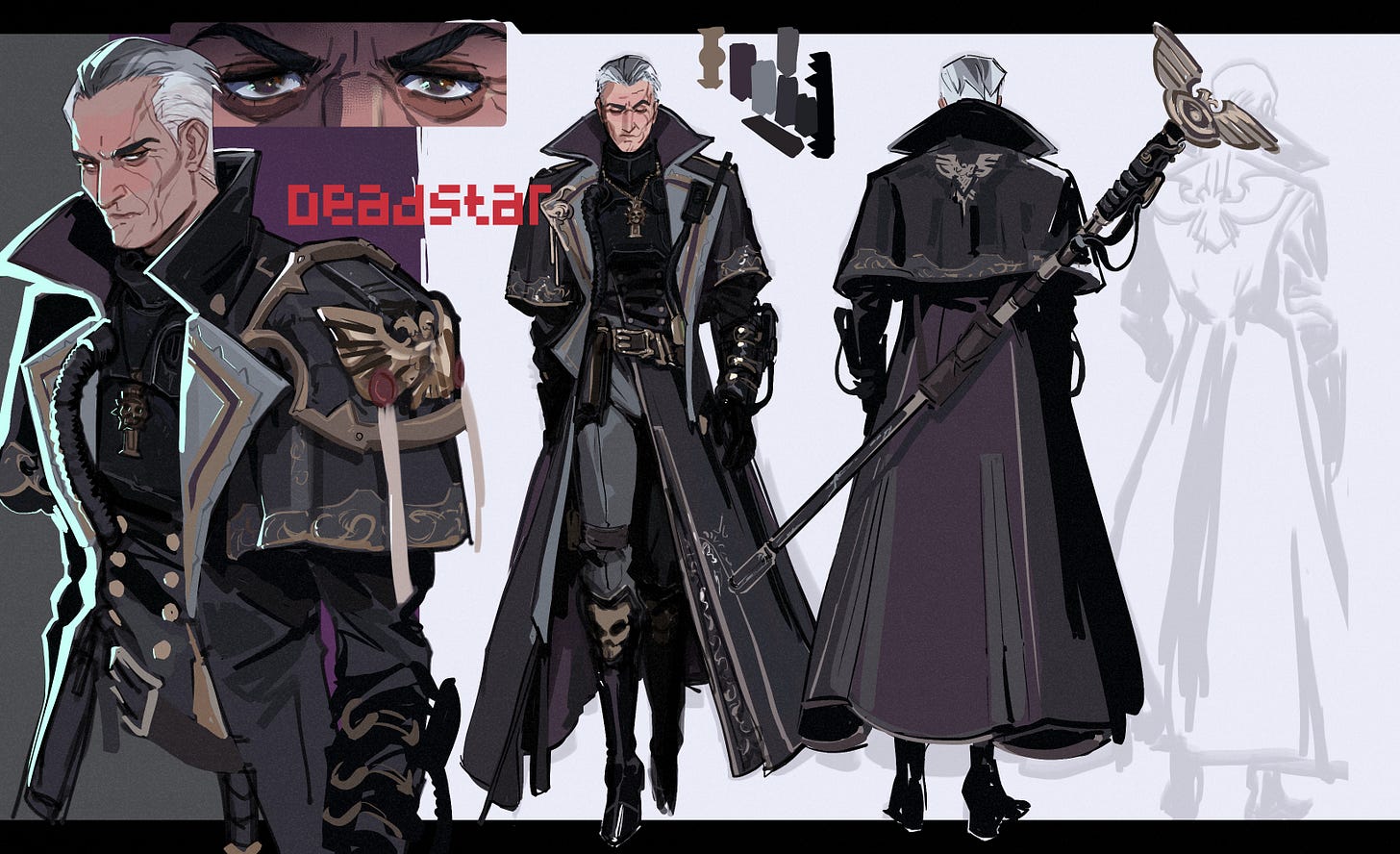Welcome to the Scriptorum
A craft-focused exploration of original Warhammer 40,000 worldbuilding
Note: All characters, narratives, and artwork featured in this series are original works created as part of my portfolio development. These materials have not been published and are intended to demonstrate craft technique and understanding of the Warhammer 40,000 universe.
What This Is
The Scriptorum is where I dissect the architecture of my Warhammer 40,000 work—the character psychology, worldbuilding decisions, narrative craft, and visual storytelling that goes into creating original fiction within the grimdark setting of the 41st Millennium.
This isn’t a story blog. It’s a craft archive. Each entry examines the “why” and “how” behind creative decisions: why a character is designed a specific way, how a world’s culture reflects its trauma, what makes dialogue feel authentically 40K, how visual design communicates psychology.
I work as both writer and artist (you can find my full portfolio at deadstar.black), so these entries combine character design sheets, comic sequences, prose excerpts, and analysis to demonstrate technique across multiple disciplines.
If you’re interested in character architecture, worldbuilding methodology, or the craft of writing within established IP, this is for you.
The Project
The work featured here centers on the Koronus Expanse and the tangled relationships between three characters:
Arch-Inquisitor Origen Thule - Ancient, patient, and terrifyingly intelligent. A master of the long game who operates on timescales measured in centuries. The singularity around which others orbit.
Lord Captain Saren von Aurastor - A Rogue Trader built entirely from scar tissue and performance. A man with no childhood memories, commanding a ship built from the wreckage of his family’s vessel, desperately running from the void inside him.
Calix von Fellner - A feudal world enforcer caught between crushing gravities. Raised in a culture of primal dominance, now navigating the labyrinthine politics of Imperial power as an unwilling prize in a game between Inquisitor and Rogue Trader.
Their dynamics—creator and creation, storm and singularity, predator and prize—drive the narrative. But more than that, they’re case studies in how to build compelling, psychologically complex characters within 40K’s framework.
What You’ll Find Here
Each Scriptorum entry focuses on a different aspect of craft:
Character Design - The psychology, visual language, and narrative function of original characters
Worldbuilding - How cultures, doctrines, and environments shape character and conflict
Dialogue Architecture - What makes speech patterns feel authentic to power dynamics and personalities
Visual Storytelling - How costume, silhouette, and sequential art communicate theme
Dynamics & Relationships - The craft of building tension between opposing forces
I approach this work as both writer and artist, so you’ll see character design sheets, comic sequences, and prose excerpts used to demonstrate technique.
The First Entries
The series launches with deep-dives into each of the three central characters:
Designing Origen Thule: Byronic stillness, economical dialogue, and why the most dangerous man in the galaxy whispers instead of screams.
Designing Saren von Aurastor: Building a character from absence, why his ship is made from his family’s wreckage, and what happens when performance becomes identity.
The Observer Between Gravities (coming soon) - Designing Calix von Fellner: Feudal dominance hierarchies, the Grave-Pelt as visual psychology, and what it means to be the prize in a game between titans.
Each post combines character art, comic sequences, prose excerpts, and craft analysis to show not just what I’m building, but how and why.
Here’s a taste of what you’ll find:
Visual Design as Psychology
Every design choice serves character function. Origen’s severe silhouette communicates containment—a man who holds immense power under absolute control. The high collar conceals daemon scars he can reveal as a weapon. The stark white hair draws attention to Lichtenberg patterns marking him as a warp-horror survivor. He doesn’t dress like an individual; he dresses like the institution itself.
Sequential Storytelling



Comics let me explore character dynamics through body language, pacing, and visual tension. How does Saren use proximity as dominance? What does it look like when someone’s mask cracks? Sequential art isn’t just illustration—it’s another tool for dissecting power dynamics and emotional architecture.
Worldbuilding Through Culture
Margard - A feudal death world where the human population was subtly reshaped by a warp-meld with Terran hounds during founding. The result: a culture built on wolf-pack hierarchy, where status is maintained through constant displays of dominance. The planet’s apex predator—the Ghoulfang—is a monstrously mutated descendant of those original hounds, and from these beasts are harvested Grave-Pelts: macabre mantles of hide and bone worn as the ultimate symbol of power.
Calix von Fellner was forged in this culture of primal law, reading kith-signs and territorial displays as naturally as breathing. Then he’s claimed by an Arch-Inquisitor as an asset and thrust into Imperial politics—a world where the hierarchies are invisible, the rules contradict themselves, and “dominance” is performed through bureaucracy and centuries-long schemes.
The collision between these worlds is the heart of his character arc.
Here’s a taste of what you’ll find:
Why I’m Doing This
The Scriptorum is both portfolio and craft journal—a public archive of the design thinking and narrative architecture behind my Warhammer 40,000 work.
Each entry examines how character psychology, worldbuilding, and visual storytelling come together within the 40K universe. I work as both writer and illustrator, so you’ll see craft demonstrated across prose, character design, and sequential art.
If you’re interested in how fiction is built within established IP, this is for you.
— D. S. Black
Find me: deadstar.black | Bluesky








the world of Margard and calix's story are some of the most immense pieces of worldbuilding I've had the pleasure of reading. the traditions, rivalries, and the newness of being foisted up into a world completely beyond his knowing and beyond the kith-signs and teeth of his own people and the process of this new war in his mind against his new masters is such a masterpiece in psychology